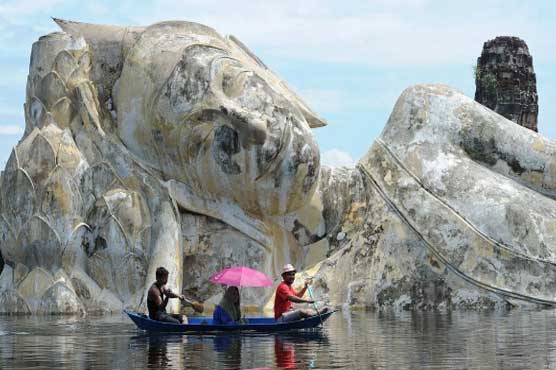With the highest violent crime rate of any large US city, Detroit has lost 63 percent of its population since 1950.
At least 78,000 buildings stand abandoned and there is enough once-inhabited empty land to fit a city the size of Paris.
"It's just hard to imagine the scale of destruction," said Faigenbaum, whose film "City of Dreams" about what he calls Detroit's "slow motion catastrophe" has just been released in France.
"Almost anywhere you go there are these houses that are just falling apart. Big houses, just totally left, just abandoned," he said.
The grandson of Jewish immigrants from eastern Europe, Faigenbaum, 64, who now lives in Paris, moved away from the city in the late 1960s.
Years later, however, following his father's death he found himself back in Detroit.
Stunned by the apocalyptic landscape, he set out to try and make sense of it all.
"Growing up there, there was always this enormous sense of possibility, that whoever or whatever you were you could make something of yourself and do something," he told AFP in an interview in Paris.
- Nightmarish vision -
"Even as a student you could get a summer job and make a lot of money. There were jobs. You didn't need much of an education, you just needed to have the will to work," he said.
The music -- blues and Motown -- for which Detroit is now famous was also a constant presence.
"There was all this amazing music. On every street corner... and it kind of expressed everything that needed to be expressed.
"Now it seems quite remarkable, but it was just what was happening."
Mixing his own family history with up-to-date reportage and archive footage, Faigenbaum's film aims to show "how the choices people make play out over 100 years".
In particular, he highlights the "Wild West capitalism" of Ford Motor Company owner Henry Ford, whose Model T -- the first affordable car for the masses -- revolutionised the automobile industry.
In 1914, Henry Ford announced he would pay workers $5 per day, double the going rate, and people flooded into the city in search of work.
By 1950 the population stood at two million and the city was the centre of the US automotive industry.
But just as the automobile helped make Detroit, it also helped to destroy it.
"At the same time as the car comes along, they're building more roads," Faigenbaum said.
"The reality of the way it played out was that it was the escape route for all the white folks who could get out."
- 'Amazing spirit' -
Land was cheap and tension between whites and blacks accelerated the exodus of whites towards newly built suburbs.
Meanwhile, the introduction of automated production in car factories sowed the seeds of future unemployment.
Faigenbaum notes that Detroit's urban decay was already well advanced in the 1980s when "devil's night" -- the night before Halloween -- would regularly see up to 800 empty properties burned down.
While making the film, Faigenbaum found himself back at his grandparents' house, now derelict and daubed with the letters R.I.P., indicating that someone had been murdered there.
In the basement, he found his long-dead grandfather's old work bench.
Later he watched as the bulldozers moved in and reduced the house to rubble.
Faigenbaum warns that Detroit's demise is a reminder that even apparently thriving cities are not "immortal".
Today, despite all its woes, young people still come to the city in search of a cheap property.
"It's hard to rain on anyone's sense of optimism but there's still such violence. All these kids come here with the dream... until their friends get carjacked or someone is held up at gunpoint," Faigenbaum said.
Nonetheless, he said he was struck by the "amazing spirit" the place still had.
"One guy said to me 'OK, it's the murder capital of the world, but it's a really friendly place!' and it's true, it's really true," he said.
"People will talk to you and they look you right in the eye, but they probably have a gun in their pocket too," he added.
-----------------------------------------------------------------------------------------------------------------
At least 78,000 buildings stand abandoned and there is enough once-inhabited empty land to fit a city the size of Paris.
"It's just hard to imagine the scale of destruction," said Faigenbaum, whose film "City of Dreams" about what he calls Detroit's "slow motion catastrophe" has just been released in France.
"Almost anywhere you go there are these houses that are just falling apart. Big houses, just totally left, just abandoned," he said.
The grandson of Jewish immigrants from eastern Europe, Faigenbaum, 64, who now lives in Paris, moved away from the city in the late 1960s.
Years later, however, following his father's death he found himself back in Detroit.
Stunned by the apocalyptic landscape, he set out to try and make sense of it all.
"Growing up there, there was always this enormous sense of possibility, that whoever or whatever you were you could make something of yourself and do something," he told AFP in an interview in Paris.
- Nightmarish vision -
"Even as a student you could get a summer job and make a lot of money. There were jobs. You didn't need much of an education, you just needed to have the will to work," he said.
The music -- blues and Motown -- for which Detroit is now famous was also a constant presence.
"There was all this amazing music. On every street corner... and it kind of expressed everything that needed to be expressed.
"Now it seems quite remarkable, but it was just what was happening."
Mixing his own family history with up-to-date reportage and archive footage, Faigenbaum's film aims to show "how the choices people make play out over 100 years".
In particular, he highlights the "Wild West capitalism" of Ford Motor Company owner Henry Ford, whose Model T -- the first affordable car for the masses -- revolutionised the automobile industry.
In 1914, Henry Ford announced he would pay workers $5 per day, double the going rate, and people flooded into the city in search of work.
By 1950 the population stood at two million and the city was the centre of the US automotive industry.
But just as the automobile helped make Detroit, it also helped to destroy it.
"At the same time as the car comes along, they're building more roads," Faigenbaum said.
"The reality of the way it played out was that it was the escape route for all the white folks who could get out."
- 'Amazing spirit' -
Land was cheap and tension between whites and blacks accelerated the exodus of whites towards newly built suburbs.
Meanwhile, the introduction of automated production in car factories sowed the seeds of future unemployment.
Faigenbaum notes that Detroit's urban decay was already well advanced in the 1980s when "devil's night" -- the night before Halloween -- would regularly see up to 800 empty properties burned down.
While making the film, Faigenbaum found himself back at his grandparents' house, now derelict and daubed with the letters R.I.P., indicating that someone had been murdered there.
In the basement, he found his long-dead grandfather's old work bench.
Later he watched as the bulldozers moved in and reduced the house to rubble.
Faigenbaum warns that Detroit's demise is a reminder that even apparently thriving cities are not "immortal".
Today, despite all its woes, young people still come to the city in search of a cheap property.
"It's hard to rain on anyone's sense of optimism but there's still such violence. All these kids come here with the dream... until their friends get carjacked or someone is held up at gunpoint," Faigenbaum said.
Nonetheless, he said he was struck by the "amazing spirit" the place still had.
"One guy said to me 'OK, it's the murder capital of the world, but it's a really friendly place!' and it's true, it's really true," he said.
"People will talk to you and they look you right in the eye, but they probably have a gun in their pocket too," he added.
-----------------------------------------------------------------------------------------------------------------









 Home
Home Politics
Politics











